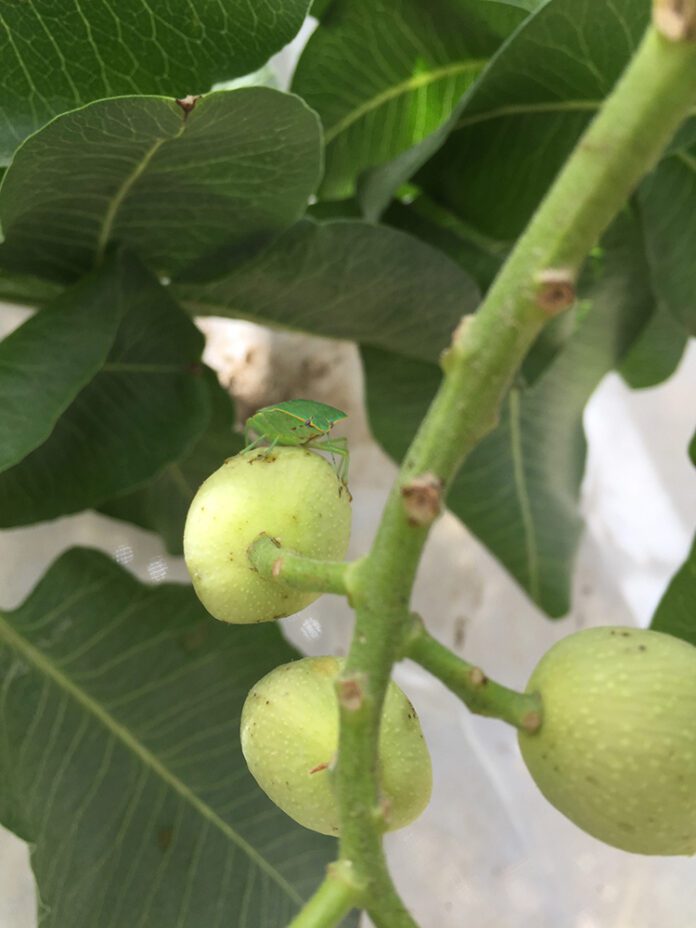
W hen you really see so much difference in a short amount of time… we would have to look at that and say, well, we’re going to have to adopt varieties because this is a 20- or 25-year planning and we’re going to have to find crops or varieties that will adapt.”
This was the response from a grower in the audience when climate change data was shared during a workshop in Tulare.
Increasing minimum temperatures, less chill accumulation and uncertain water supplies are signals agriculture practices may need to adapt to continue sustainable production. A recent workshop by the UCCE focused on adapting fruit and nut production practices in the San Joaquin Valley to meet the challenges of climate change and mitigate effects on crop production and changes in insect damage.
Tapan Pathak, specialist in climate adaptation in agriculture at UC Merced, said minimum temperatures in California from 1895 to 2020 have trended upward over that period. The 30-year average temperature from 1961 to 1990 was 76.2 degrees F. The projection for 2035 to 2064 is an increase to 81.6 degrees F. While extremes in precipitation are expected to occur, there are no trends showing wetter or drier years. A loss of snowpack in the Sierra was predicted as average temperatures are projected to increase by 7 to 19 degrees F. Days where the daily maximum temperature is above 103.9 degrees F are predicted to increase and occur earlier in the year.
While the frost-free growing season for crops is expected to lengthen, Pathak said there is the potential for temperature-related impacts on crop quality. Yields for annual crops safflower, wheat and rice are expected mainly due to high temperatures causing shorter duration of phenological phases.

Pathak said loss of chill accumulation will impact many specialty crops. From 1950 to 2020, chill accumulation has decreased 20%, and more significant reductions are forecast. This loss of chill also includes lower risk of frost injury.
While the potential for negative effects on agriculture exists, Pathak said there are pathways to climate-smart agricultural practices. Those include localized research and innovations that integrate scientific, social and economic factors that provide viable solutions for growers.
“Simply providing the scientific facts is inefficient,” Pathak said. “Solutions need to integrate stakeholder challenges and help them translate the science into actionable strategies.”
Risk Management Strategies
Risk management strategies for insect pests and diseases will be necessary in the future due to warming trends, Jhalendra Rijal, UCCE statewide IPM advisor, said. Insect growth, reproduction and behavior are highly influenced by temperatures.
Climate change parameters that are trending upward are carbon dioxide and temperatures. Rijal said increased CO2 can affect plant physiology. It increases the carbon to nitrogen ratio of plant tissues, causing insects to accelerate their food intake to compensate for reduced leaf nitrogen content. Higher CO2 levels can also affect insect fecundity, insect density and abundance.
Some of the results of increased temperatures are altered pest distribution and reemergence, overwintering survival, shifts in pest phenology and increased risk of pesticide resistance.
Highlighting navel orangeworm (NOW), Rijal said the first-generation lifecycle can be shortened by almost six weeks. A fifth generation of NOW is now expected to occur in three tree nut-producing counties by 2024. Codling moth, spider mite and European red mite are also predicted to produce more generations.
on to temperature effects, drought years also provide a more favorable environment for insect growth. Drought-stressed plants are more attractive to insects and may also induce genetic changes, including the potential for insecticide resistance. Mites grow and reproduce better under hot and dry conditions, Rijal said.
Walnut husk fly has improved survival as dry late winters can potentially increase pupal survival in the soil. Low chill accumulations in the winter can result in unsynchronized and protracted adult emergence in the summer, making control measures difficult.
An increase in stink bug activity in almonds was noted by Rijal as well as the threat of brown marmorated stink bug. Long-term risk management for these pests includes development of monitoring tools and work to evaluate the spray timing to control the green stink bug.
Rijal suggested that to deal with long-term implications of drought, prior to establishing an orchard, think about water availability for the life of the orchard. Efficiency with irrigation, seeking drought, high temperature-tolerant traits and use of cultural practices to reduce evapotranspiration are also ways to deal with a changing climate.
Crop Quality Challenges
A panel discussion about crop production and quality challenges due to warmer temperatures featured remarks by James Nichols of Nichols Farms; Sebastian Saa, Almond Board of California; and Steve Vasquez, California Pistachio Research Board.
Smoke and extreme heat at harvest marked two of the last three years, Nichols said. Smoke delayed drying time in 2021, and heat in 2022 caused poor nut removal.
“There are some things you can’t control,” Nichols said.
Mitigating high temperatures with sun-reflecting materials and waiting longer in the fall and winter to conduct mummy shakes are two adaptations they have tried, Nichols said. They have also increased the number of acres under mating disruption to combat NOW.
Almonds are blooming earlier, Saa said, leaving them susceptible to frosts. Smoke from fires or cloudy days also affects trees’ ability to store carbohydrates. Cover crops to improve water infiltration and using an IPM approach to pest and disease management are management tools growers can use to protect tree health and crop quality.
It is CPRB’s role to find opportunities to solve these issues, Vasquez said. One need, he said, is weather stations to reflect local conditions to help growers make better decisions.
Nichols said more research on cover crops would be helpful, particularly in making decisions on water use. Their own trials with cover crops show they can help increase yields and reduce dust, but their water use is a barrier to adoption by some growers.
Commodity groups play a crucial role in helping growers make decisions regarding effects of climate change. Funded research in water use efficiency, nitrogen efficiency and sensing technologies increase growers’ ability to do more with less, Saa said.
The concern in the future is when groundwater pumping is restricted. Recharge and water banking can be a solution, Saa said, but increasing water use efficiency, sensing and automation are all part of a long-term Almond Board study.
Local Adaptation
Case studies on regional and local adaptation practices were part of the workshop. Rootstocks, winter cover cropping and whole orchard recycling were featured.
Mohammad Yaghmour, UCCE Kern County farm advisor, said considerations before almond rootstock selection include soil type, irrigation water analysis, nematode testing and history of the orchard site. Recognizing the potential for extreme weather events, including high winds, rootstock anchorage is an important part of selection.
Daniele Zaccaria, agricultural water management specialist at the UC Davis Dept. of Land, Air and Water Resources, presented his research on winter cover crops.
Significant medium- and long-term benefits to winter cover crops were documented in his research. They included better soil aggregation and stability, improved infiltration and porosity, increased soil moisture storage, less soil crusting and sealing. Soil erosion was controlled, and effective salt leaching was achieved for the same amount of water applied.
Cover cropping is being promoted by federal and state agencies offering financial incentives to improve soil health and mitigate effects of climate variability.
Carbon sequestration, reduction of nitrogen leaching and improved soil fertility can be achieved with whole orchard recycling, UCCE orchard systems advisor Brent Holtz said. Wood-chipped almond orchard soils contain more wood-rotting basidiomycetes and bacterial- and fungal-feeding nematodes. The soil also has increased nutrient levels, lower pH and more organic matter.
CDFA’s Healthy Soils Program and USDA’s Environmental Quality Incentives programs have approved this practice for incentives. A bill signed in 2022 designated $178 million for whole orchard recycling projects.

Cecilia Parsons | Associate Editor
Cecilia Parsons has lived in the Central Valley community of Ducor since 1976, covering agriculture for numerous agricultural publications over the years. She has found and nurtured many wonderful and helpful contacts in the ag community, including the UCCE advisors, allowing for news coverage that focuses on the basics of food production.
She is always on the search for new ag topics that can help growers and processors in the San Joaquin Valley improve their bottom line.
In her free time, Cecilia rides her horse, Holly in ranch versatility shows and raises registered Shetland sheep which she exhibits at county and state fairs during the summer.















